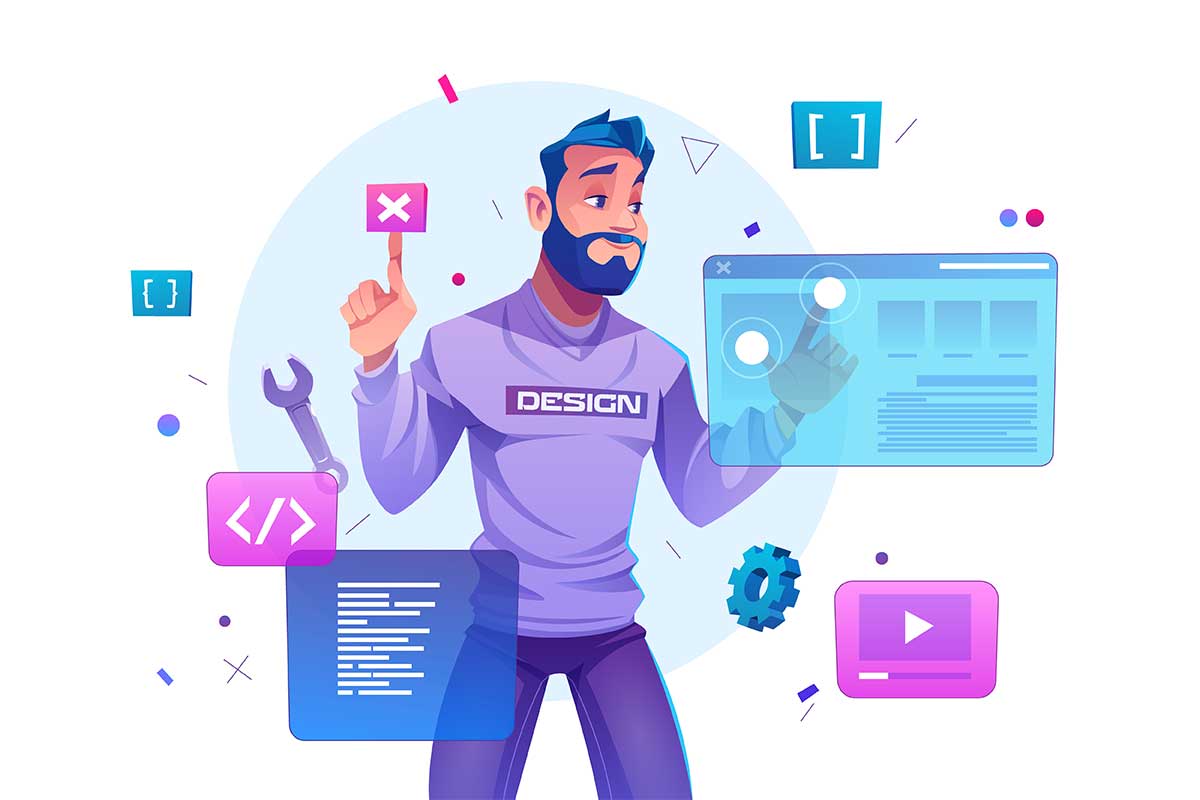Table of Contents
Introduction
In the expansive digital landscape, the undeniable prowess of WordPress as a platform stands out. A haven for many web design elements, it seamlessly marries basic web design elements with advanced features, breathing life into the virtual world. Yet, understanding the fine line between generic website design elements and the specific nuances required by specialized industries is crucial. Today, we delve deep, exploring how these foundational WordPress design elements can be finely tuned to resonate with any niche, ensuring every website tells its own unique story.
Understanding WordPress Design Elements
WordPress has its own special set of tools and features known as WordPress design elements. Think of these like the unique ingredients in a recipe. But how do they compare to most websites’ regular web design elements? Well, every website, WordPress or not, relies on some basic web design elements – these are the essentials, like flour in most baking. Then, specific website design elements make WordPress sites stand out. Let’s dive in to see what makes them different and sometimes, quite similar.
Core Website Design Elements
Every website, no matter where it’s built, has some foundational pieces – think of them as the backbone or the building blocks. These are the basic web design elements, like the pillars that support a building. Some things remain universal whether we’re discussing WordPress design elements or broader website design elements. But what are these essential components that every site needs? And how do they intertwine with the unique elements of platforms like WordPress? Let’s delve into the heart of web design and discover the core pieces every digital space should embody.
Typography and Readability
Typography, the art of arranging type, is a cornerstone in the realm of web design elements. But how does it play out in the diverse world of WordPress and its unique offerings? Let’s explore:
Basic Web Design Elements:
Font Choice: A critical component of web design, the right font can dramatically influence user experience and perception. It’s one of those basic web design elements that can make or break a website’s aesthetic.
Layout: Organizing text cleanly and legibly ensures readability and user engagement. Here’s a website layout example for a coffee shop.
WordPress Design Elements:
Customizable typography features in WordPress can further enhance the website’s appeal and function. With a vast array of plugins and themes, the platform brings typography to life in dynamic ways.
Conveying Ethos with Typography:
For businesses, especially those in specialized fields like Watermark Design, typography isn’t just about looks. The choice of font and layout can express the brand’s ethos, mirroring its values and aspirations in a subtle, yet impactful way.
Whether we’re looking at universal website design elements or the specificities of WordPress design elements, typography remains an indispensable tool in carving out a site’s identity and ensuring its readability.
Responsive Design
In today’s digital age, responsiveness isn’t just a buzzword – it’s an essential criterion for any website. But how do WordPress design elements factor into this, and how do they intersect with other web design elements to guarantee seamless user experiences?
Adaptable WordPress Websites:
Using WordPress design elements, one can craft sites that fluidly adapt to many devices, be it a smartphone, tablet, or desktop. The myriad of themes and plugins available within WordPress ensures that your site looks and functions optimally, regardless of screen size.
The Role of Basic Web Design Elements:
Elements such as grids, flexible images, and media queries form the backbone of responsive design. These basic web design elements ensure content is displayed appropriately, whether browsing on a 4-inch phone or a 27-inch monitor.
Web Design Elements and Fluidity:
At the heart of responsive design is the concept of fluidity. Website design elements must work harmoniously, allowing content to shift and resize seamlessly. This fluid nature ensures a consistent and user-friendly experience across platforms.
While WordPress offers its specialized toolkit to achieve responsiveness, integration with broader web design elements brings adaptability and fluidity to life on the web.
Imagery and Media
A picture speaks a thousand words, and in the digital sphere, the right imagery and media are quintessential web design elements that bring a website’s narrative to life. As we venture into WordPress, how do these elements coalesce to create a compelling visual story?
High-Quality Images for Watermark Design:
Utilizing high-quality and relevant images becomes pivotal in the panorama of website design elements, especially for specialized niches. Such images elevate aesthetics and resonate with the brand’s ethos and audience.
WordPress Design Elements for Media:
WordPress stands out with its robust tools and plugins tailored for media integration. WordPress design elements ensure they’re showcased elegantly and effectively, whether it’s an image gallery or video montage.
Balancing Multimedia with Site Performance:
Integrating media is essential, but so is site speed. Basic web design elements come into play here, guiding the optimization and efficient embedding of media. This ensures visuals enhance, not hinder, the user experience.
The interplay between WordPress-specific tools and fundamental web design elements is crucial in crafting a visually rich site. It’s about striking the right balance: stunning imagery for Watermark Design and seamless site performance.
Navigation and User Experience (UX)
In the digital realm, navigation isn’t just about getting from point A to B; it’s about the journey and the story that unfolds along the way. As we weave through the corridors of WordPress and the broader landscape of web design, let’s uncover how these elements shape this pivotal journey.
Crafting Intuitive Navigation:
At the heart of any website lie its navigation features. Utilizing WordPress design elements, one can craft an intuitive and streamlined navigation structure, making it a breeze for visitors to explore the content they seek.
The Role of Basic Web Design Elements in UX:
Basic web design elements play a fundamental role in sculpting the user’s journey. Elements like breadcrumbs, dropdown menus, and call-to-action buttons ensure a user-friendly and guided experience throughout the website.
Enhancing User Journeys with Website Design Elements:
Beyond just moving through a site, it’s about the experience. Website design elements, be it on WordPress or any other platform, are geared to elevate this experience, ensuring each user interaction is meaningful and memorable.
In essence, WordPress provides its unique toolkit to enhance navigation and UX, and the symbiotic relationship with the broader web design elements ensures every click, scroll, and interaction is delightful.
Integration with Social Media and Other Platforms
In today’s interconnected digital world, a website isn’t just an isolated entity; it’s a node in a vast network. The seamless integration of a site with social media and other platforms is fundamental. So, how do WordPress design elements and traditional web design elements come together to bridge this connection?
WordPress Tools for Social Integration:
One of the hallmarks of WordPress is its plethora of plugins specially tailored for social sharing and integration. These WordPress design elements allow businesses to effortlessly link their site to platforms like Facebook, Twitter, and Instagram, enhancing reach and engagement.
Basic Web Design Elements for Connectivity:
While WordPress offers its specialized tools, the core or basic web design elements play a role in designing interactive buttons, feed embeds, and share icons. These elements work behind the scenes to ensure a fluid transition between the website and external platforms.
The Imperative of Staying Connected:
In this age of digital omnipresence, businesses can’t afford to be islands. Integrating website design elements that link to social media and other platforms is no longer a luxury; it’s a necessity. Such integration ensures businesses maintain a robust digital pulse, fostering community and driving growth.
While WordPress provides its distinct tools for enhanced connectivity, the broader palette of web design elements ensures that this integration is seamless, efficient, and aligned with the digital aspirations of businesses.
Security and Speed
In the vast expanse of the digital realm, two attributes stand paramount: security and speed. While the former shields your online haven from lurking threats, the latter ensures visitors aren’t left twiddling their thumbs. But how do WordPress design elements and other web design elements come into play to fortify these two pillars?
Fortifying WordPress Sites:
WordPress is renowned for its unique arsenal of plugins and tools, with many dedicated to enhancing site security. These WordPress design elements act as sentinels, monitoring potential threats and safeguarding the website’s sanctum from breaches.
Basic Web Design Elements for Security:
Beyond the WordPress-specific tools, basic web design elements like SSL certificates, secure login forms, and captcha verifications form the bulwark against cyber threats. These elements, universal to most sites, are the bedrock of online security.
The Need for Speed:
Dive deeper into website design elements, and you’ll find tools and techniques focused on optimizing site speed. From image compression to caching, these elements are vital in ensuring swift page loads, enhancing user retention.
Speed and SEO:
A website’s velocity isn’t just about user experience. Speed, one of the core web design elements, has a significant bearing on SEO rankings. A brisk site not only delights visitors but also finds favor with search engine algorithms.
We’re talking about WordPress-specific tools or the broader scope of website design elements; the twin goals of robust security and swift speed remain central, dictating the success and resilience of any digital outpost.
SEO-Friendly Design
In the ever-evolving maze of the digital ecosystem, standing out is more crucial than ever. SEO (Search Engine Optimization) is the compass guiding users to your digital doorstep. But how do WordPress design elements and broader web design elements work in tandem to craft an SEO-friendly design, especially for niches like Watermark Design?
Integrating SEO Principles:
With its extensive toolkit, WordPress offers an array of plugins tailored for SEO. These specific WordPress design elements enable easy meta tag integration, image optimization, and content analysis, laying the foundation for SEO-centric design.
Website Design Elements and SEO:
Beyond WordPress tools, there are basic web design elements integral to SEO. Use attributes like mobile responsiveness, clear URL structures, and site maps. These elements, often overlooked, play a pivotal role in making a website more palatable to search engines.
Ranking High with Design:
For specialized sectors like Watermark Design, it’s not just about having an online presence but ensuring it’s visible. By intertwining SEO principles with website design elements, businesses can bolster their rankings, ensuring they’re both present and prominent.
Discoverability in a Crowded Space:
In today’s crowded digital marketplace, mere existence isn’t enough. Using a blend of WordPress and general web design elements, businesses can carve a distinct pathway for users, making their sites easily discoverable amidst the noise.
A truly SEO-friendly design isn’t just about keywords or backlinks. It’s the harmony between WordPress design elements and foundational web design elements, ensuring a website’s visibility isn’t just beautiful and beacon-like.
Conclusion
In the dynamic tapestry of the digital world, mastering the art of blending aesthetics with functionality is paramount. By fusing WordPress design elements with the core of web design elements, one can sculpt a website that mesmerizes visually while ensuring peak performance, superior user experience and pronounced search visibility.
While WordPress as a platform extends a vast toolkit for all designers, genius emerges when these specialized tools are synergized with the foundational web design elements. This merger ensures that every design facet, from intricate animations to compelling content, serves a purpose: to captivate and perform.
This is where the prowess of Watermark Design shines the brightest. As a leading WordPress development company, Watermark Design has showcased time and again its adeptness in intertwining the nuances of WordPress website design with the broader contours of website design elements. It’s not just about having a presence in the digital domain; it’s about making an impactful statement.
In summation, the artistry of web design is not limited to color palettes or typography choices. It’s the orchestrated interplay between aesthetics and utility. And for those seeking the zenith of such orchestration, Watermark Design stands as the beacon, guiding businesses towards digital distinction.



0 Comments